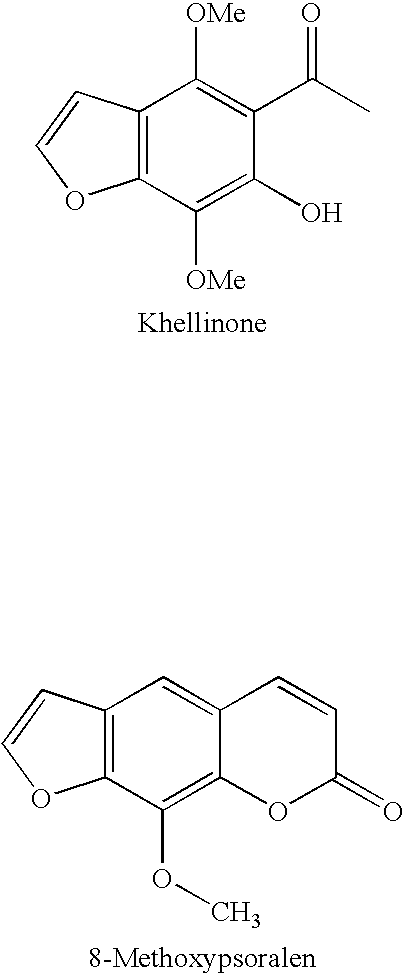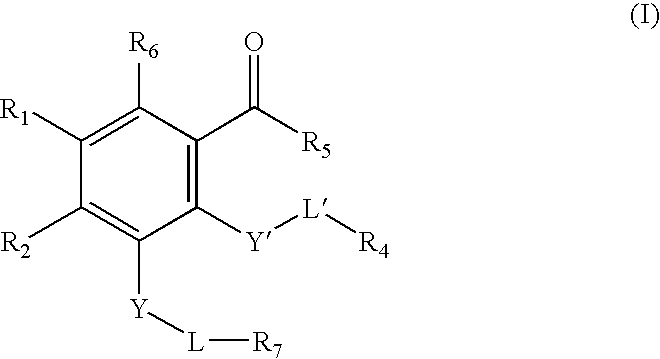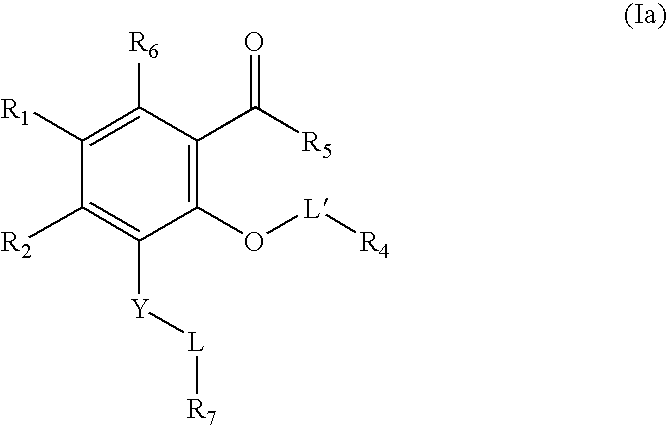Aryl potassium channel blockers and uses thereof
a potassium channel blocker and potassium channel blocker technology, applied in the field of compounds, can solve the problems of increased medical care costs and income loss, inflammation and scarring, damage to blood vessels,
- Summary
- Abstract
- Description
- Claims
- Application Information
AI Technical Summary
Benefits of technology
Problems solved by technology
Method used
Image
Examples
example 1
1a) 2-(3-(4-Fluorophenyl)propoxy)-1,3-dimethoxy-5-methylbenzene
[0163]3,5-Dimethoxy-4-hydroxy-toluene (1.0 g, 5.95 mmol) and 1-(3-bromopropyl)-4-fluorobenzene (1.5 g, 6.15 mmol) were reacted as described under General Procedure A and the crude product was purified by flash chromatography (silica-gel, hexane / Et2O 19:1) to afford the title compound (1.64 g, 91%) as a colourless oil. 1H NMR (300 MHz, CDCl3) δ 7.31-7.19 (m, 6H), 4.06 (t, J=6.4 Hz, 2H), 3.95 (s, 3H), 3.90 (s, 3H), 2.81 (t, J=7.7 Hz, 2H), 2.46 (s, 3H), 2.10-2.05 (m, 2H).
[0164]
1b) 1-(3-(3-(4-Fluorophenyl)propoxy)-2,4-dimethoxy-6-methyl-methylphenyl)ethanone
[0165]Example 1a (380 mg, 1.25 mmol) was reacted as described under General Procedure B and the crude product was purified by flash chromatography (silica-gel, hexane / Et2O, gradient to 1:4) to afford the title compound (409 mg, 95%) as a light cream oil. 1H NMR (300 MHz, CDCl3) δ 7.19-7.14 (m, 2H), 6.98-6.92 (m, 2H), 6.47 (s, 1H), 3.97 (t, J=6.3 Hz, 2H), 3.87 (s, 3H), 3.8...
example 2
[0174]
1-(3-Chloro-6-(cyclopentylamino)ethoxy)-5-(3-(4-fluorophenyl)propoxy-4-methoxy-2-methylphenyl)ethanone
[0175]Example 1e (180 mg, 0.40 mmol) was reacted with cyclopentylamine (4 mL) as described under General Procedure G and the crude mixture was purified by flash chromatography (silica-gel, DCM / EtOAc / MeOH 1:0:0, 9:8:2) to afford the title compound (32 mg, 17%) as light cream oil. 1H NMR (300 MHz, CDCl3) δ 7.17-7.13 (m, 2H), 6.98-6.92 (m, 2H), 4.13 (t, J=5.2 Hz, 2H), 4.03 (t, J=6.4 Hz, 2H), 3.86 (s, 3H), 3.09-3.05 (m, 1H), 2.84 (t, J=5.2 Hz, 4H), 2.77 (t, J=7.4 Hz, 2H), 2.48 (s, 3H), 2.18 (s, 3H), 2.03-1.97 (m, 2H), 1.85-1.75 (m, 4H), 1.37-1.23 (m, 2H). MS (ES+) m / z 477.9 (M+H+).
example 3
[0176]
3a) 4-[3-(4-Fluoro-phenyl)-propoxy]-3,5-dimethoxy-1,2-dimethyl-benzene
[0177]Example 1a (1.0 g, 3.14 mmol) was reacted as described under General Procedure E Step i) to afford the bromide intermediate (1.16 g, 93%). A portion of this material (500 mg, 1.3 mmol) was reacted as described under General Procedure E Step ii) and the crude residue was purified by flash chromatography (silica-gel, hexane / Et2O 19:1) to provide the product as a clear oil (310 mg, 75%). 1H NMR (300 MHz, CDCl3) δ 7.20-7.15 (m, 2H), 6.97 (m, 2H), 6.49 (s, 1H), 3.97 (t, J=6.3 Hz, 2H), 3.81 (s, 3H), 3.79 (s, 3H), 2.81 (t, J=7.5 Hz, 2H), 2.21 (s, 3H), 2.10 (s, 3H), 2.06-1.96 (m, 2H).
[0178]
3b) 1-{3-[3-(4-Fluoro-phenyl)-propoxy]-2,4-dimethoxy-5,6-dimethyl-phenyl}-ethanone
[0179]Example 3a (180 mg, 0.57 mmol) was reacted as described under General Procedure B and the crude product was purified by flash chromatography (silica-gel, hexane / EtOAc, 9:1) to afford the title compound as a clear oil (55 mg, 27%). 1H NMR ...
PUM
| Property | Measurement | Unit |
|---|---|---|
| particle size | aaaaa | aaaaa |
| temperature | aaaaa | aaaaa |
| temperature | aaaaa | aaaaa |
Abstract
Description
Claims
Application Information
 Login to View More
Login to View More - R&D
- Intellectual Property
- Life Sciences
- Materials
- Tech Scout
- Unparalleled Data Quality
- Higher Quality Content
- 60% Fewer Hallucinations
Browse by: Latest US Patents, China's latest patents, Technical Efficacy Thesaurus, Application Domain, Technology Topic, Popular Technical Reports.
© 2025 PatSnap. All rights reserved.Legal|Privacy policy|Modern Slavery Act Transparency Statement|Sitemap|About US| Contact US: help@patsnap.com



